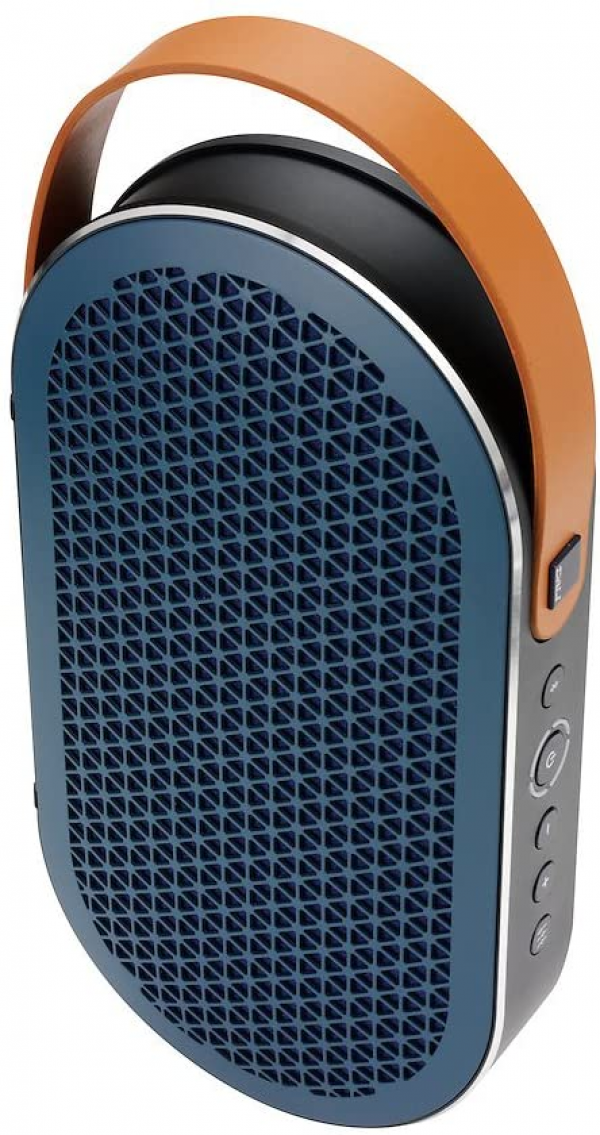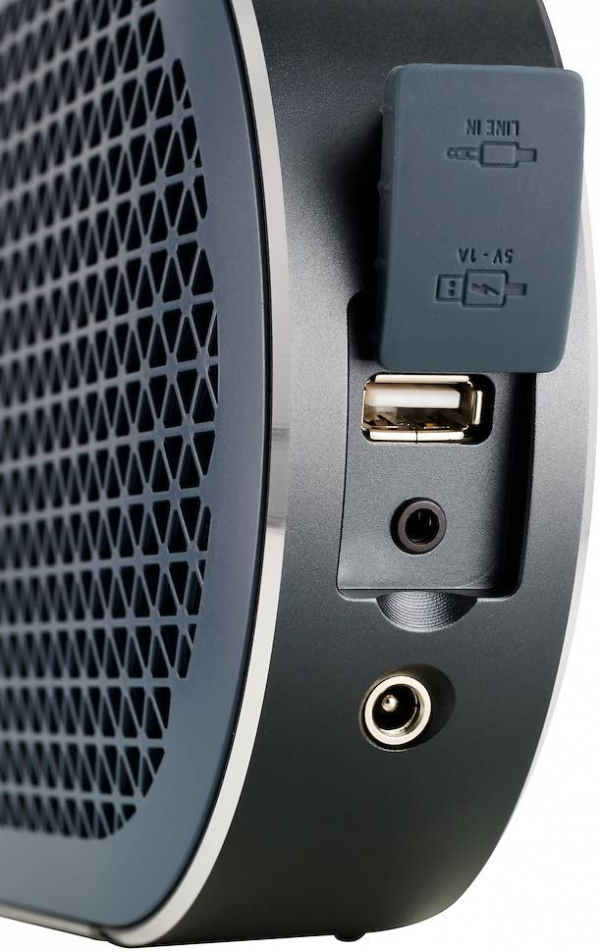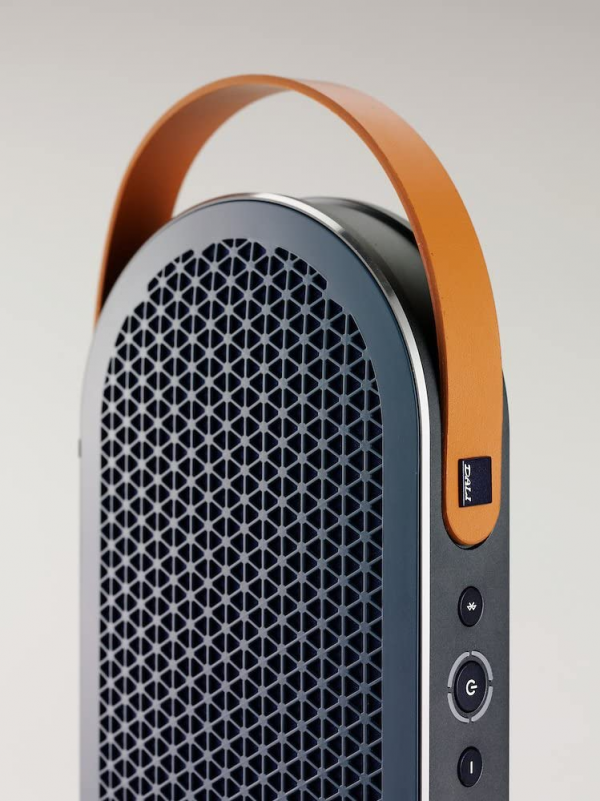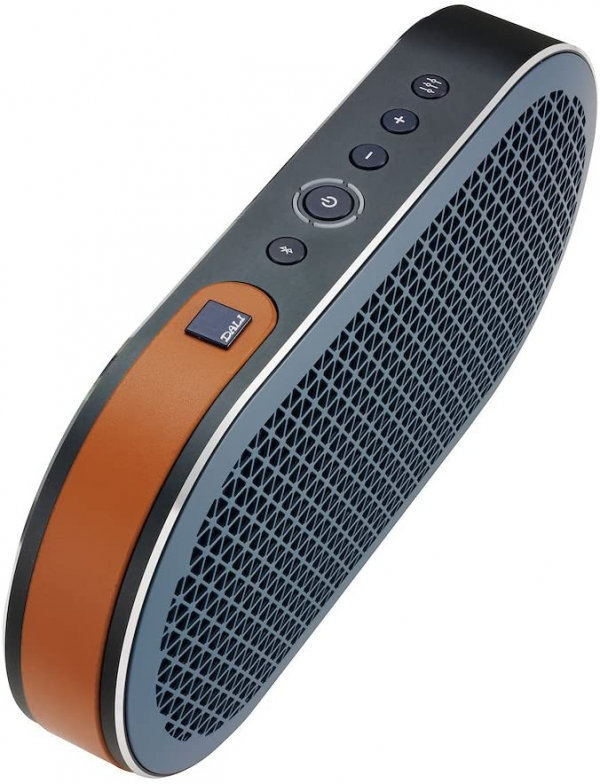Dali
Dali Katch: a portable enclosure to tame
Aprox. 499€ - see price -
See specificationsDenmark never stops investing in the world of portable audio. Latest manufacturer in the country of Andersen to embark on this universe, the hi-fi Dali presents the Katch, its very first portable speaker. A nice catch?
Positive points
Remarkably precise treble.
Nice sitting in the grave.
Perfectly contained distortion.
Excellent autonomy (16 hours).
USB socket for recharging a mobile device.
Bad points
Strange stereo.
High volume pumping.
Very chick Bluetooth controls, no hands-free kit.
Our review
Ergonomics
Danish, by its design, the Dali Katch is quite ostentatious. We recognize from afar the clean curved lines which are often the signature of Scandinavian designers, enhanced by a very nicely textured aluminum strapping. The grids, on the other hand, inspire less praise: made of a fairly flexible plastic, it is feared that they only provide very modest protection to the speakers in the event of an impact. The enclosure is also in no way protected against water: it is therefore not intended for backpackers.
27 cm wide and 1.1 kg on the scale, the Katch is slightly above the limit between portable speakers and transportable speakers in our comparison, but it remains quite compact.
To its Bluetooth 4.2 compatibility (SBC and aptX codecs), the Katch adds an auxiliary input on 3.5 mm mini-jack, and no other audio connections. When using wireless, we regret the very limited number of controls available on the speaker: volume control ... and that's it. It is not possible to navigate between tracks, or even pause or start playback. Add to that the absence of a hands-free kit and the impossibility of connecting several sources simultaneously: from a functional point of view, the speaker demonstrates excessive minimalism.
Next to the volume adjustment buttons is the button allowing you to switch between the "Clear" and "Warm" audio modes - the effects of which will be detailed in the Audio part of this test. Note that it is possible to combine two Katchs into a stereo pair; unfortunately we could not test this function, having only had one copy at our disposal.
Finally, the last thing to note is the welcome presence of a USB Type-A socket that can be used to charge a mobile device or power a streaming device such as a Chromecast (5 V / 1 A output).
The built-in battery provides the speaker with a range of up to 16 hours according to our measurement (volume set to half of its maximum value). A very good result, which places the Katch among the best speakers of our comparison on this criterion.

Audio
The Dali Katch offers excellent audio performances in absolute terms, but which show a very surprising particularity. This is linked to the way the speaker reproduces stereophony: the Katch does have two channels (each consisting of a tweeter, a woofer and a passive bass radiator), but they are not positioned to the left and right of the enclosure: instead, they are located ... in front and behind.
The right channel is therefore emitted towards the front of the speaker, while the left channel is projected at the rear. It goes without saying that this provision has absolutely no chance of creating any precision in spatialization. That said, it is not necessarily harmful provided: as long as the speaker is located in a room with a minimum reverberation, the left channel can manage to be heard without too much inconsistency with the right channel. This acoustic condition must however absolutely be fulfilled so that one can really take advantage of the loudspeaker's sonic talents - which she is very big, by the way.
The Katch stands out above all by the very fine precision of its treble. Significantly highlighted by the frequency response, they give the speaker a very clear sound, but never aggressive. Cymbal shots for example are rendered with a lot of energy and definition but without the slightest acidity.
This clarity may not be to everyone's taste, but in this case, a parade exists: activate the "Warm" mode of the speaker. A little boost is then given to the bass, so as to significantly balance the sound. The rendering then becomes very flattering, the small bump in the low mids giving a fairly round and warm sound. The extension in the bass extremes, for its part, is not spectacular for a speaker of this size, but the very good control of the low frequencies, clear and responsive, is enough to give the feeling of a very satisfactory seat.
A little warning must be given regarding the power available: the Katch has a very impressive reserve of sound volume, but only a part of it can be used; in question, a violent compression of dynamics which is activated as soon as one exceeds approximately two thirds of the level adjustment. This type of device is certainly very common in the world of portable audio, but it is particularly poorly implemented here: the compression is applied with an extremely long return time, which makes the pumping effect particularly obvious and unpleasant.
It should also be noted that when the speaker is used connected to the mains rather than the battery, its power is unbridled, and we can climb a few decibels higher. A detail that turns out to be perfectly anecdotal, since at this level, we are already very much above the activation threshold of compression.
Latency in Bluetooth is around 165 ms, an average result for speakers of this type. In the absence of compensation for this delay when watching a video, the audio / image lag is impossible to forget, but people who are the least sensitive to this problem can get used to it.

Conclusion
The biggest flaw of the Dali Katch is its lack of versatility: simplistic in terms of its functionality and opting for a very unconventional stereophony which allows it to sound good only in rooms with fairly reverberant acoustics, it poses many conditions to the appreciation of his musical qualities. The fact remains that these are remarkable, and deserve ample attention.

Specifications
Reviews


Service is non existant
The speaker sounds great but if you need any parts forget it. My charger quit working and to get a new one it will take 3 to 4 months per Dali. There is not a service center in the whole United States. The part is being shipped by boat from Denmark to Canada then it has to go through customs again to get into the US.
I did own Dali Euphonias and the same thing happened with them. $ 10,000 speakers and no parts available. Just a tip. If your going to buy a speaker that will travel with you, things are bound to happen. Buy a speaker rom someone who can service it when needed.
After speaking with 3 or 4 different people with Dali I was told they would send me the part in ten days. 14 days later I received a part from Dali. Unfortunately it was the wrong part. Do yourself a favor and buy something where if you need service or parts they are available. Dali parts are dam near impossible to find.
compared side by side I find this to have best sound quality
I have been investigating and trying out different speakers which received high praises, JBL charge 3, extreme, Bose revolve +, compared side by side I find this to have best sound quality. Percussions and voices are natural and crystal clear without being too sharp. Base is as good as any larger Bluetooth speakers but tight without being boomy. It is a stereophile Bluetooth speakers. I have used it battery operated for last three days with average 4-6 hrs listening and the battery indicator still have over 50% juice left. I have previous brought this speaker from Japanese reseller but have to return it because it could not be charged and battery operated. I am very pleased I brought this product. Best for portability, sound, and value if you can afford it.
The winner
As a musician I've been traveling for more than 18 years, and the need for a great portable speaker was always there, to work, to listen to mixes or just to stay updated with the music in the world, I tried everything, from the first Sony's and Logic to the Bose line, passing trough the B&W and the B&O, some of them with very good audio quality but a lack of battery life, and sometimes with a need of a little more punch or volume. Finaly I get to the Dali Katch, that combines everything I've been looking for for years, easy connectivity, amazing sound in definition and quality, tremendous volume without distortion and a long long battery life. Very resistant and reliable speaker, pricey and not very small but in an overall view, the best option out there.
Dali Katch; Blue Tooth Speaker Excellence.
The Dali Katch speaker is an absolutely superb wireless blue tooth speaker. In its price range, it's arguably the finest and most portable speaker available. It's superbly designed, extremely compact, portable, well made and the general over excellence of the sound field it produces cannot be exaggerated. I'm extremely pleased with my purchase. My highest recommendation.
Love it!
I love the sound and the looks are appealing to me. Can fill my room with clean, articulated and well defined music with no distortion or exaggerated emphasis.
Great speaker
Great speaker - read the good and the bad reviews and went ahead and bought one - not sorry I did. I get that some may have issues but I really like the quality sound - the volume is totally ample for my use - while it was a bit on the pricey side I don't mind as I really like the unit.